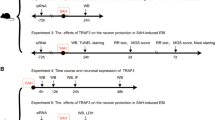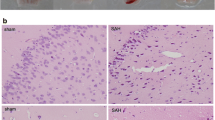Abstract
This study aims to clarify the potential role of Raf-1 kinase in cerebral vasospasm (CVS) and early brain injury (EBI) after subarachnoid hemorrhage (SAH). Two experimental SAH models in rats, including cisterna magna double injection model for CVS study and prechiasmatic cistern single injection model for EBI study, were performed in this research. As a specific inhibitor of Raf-1, BAY 43-9006 was used in this study. In CVS study, time course study showed that the basilar artery exhibited vasospasm after SAH and became most severe at day 5, and the phosphorylation of Raf-1 had the same trends, while both vasospasm and the phosphorylation of Raf-1 induced by SAH were inhibited by BAY 43-9006 treatment. In addition, BAY 43-9006 treatment significantly reversed the phosphorylation of ERK1/2 and the activation of NF-κB induced by SAH and decreased the messenger RNA (mRNA) levels of IL-6 and IL-1β. In EBI study, BAY 43-9006 treatment significantly suppressed the brain injury induced by SAH. Besides, BAY 43-9006 inhibited the phosphorylation of Raf-1 and ERK1/2; decreased the protein levels of COX-2, VEGF, and MMP-9; and reversed the activation of NF-κB induced by SAH. These results demonstrate that Raf-1 kinase contributes to CVS and EBI after SAH by enhancing the activation of the Raf-1/ERK1/2 and Raf-1/NF-κB signaling pathways, and that the inhibition of these pathways might offer new treatment strategies for CVS and EBI.








Similar content being viewed by others
Change history
16 April 2024
A Correction to this paper has been published: https://doi.org/10.1007/s12035-024-04153-0
References
Suarez JI, Tarr RW, Selman WR (2006) Aneurysmal subarachnoid hemorrhage. N Engl J Med 354(4):387–396. doi:10.1056/NEJMra052732
Kassell NF, Sasaki T, Colohan AR, Nazar G (1985) Cerebral vasospasm following aneurysmal subarachnoid hemorrhage. Stroke J Cereb Circ 16(4):562–572
Loftspring MC (2010) Iron and early brain injury after subarachnoid hemorrhage. J Cereb Blood Flow Metab Off J Int Soc Cereb Blood Flow Metab 30(11):1791–1792. doi:10.1038/jcbfm.2010.139
Grasso G (2004) An overview of new pharmacological treatments for cerebrovascular dysfunction after experimental subarachnoid hemorrhage. Brain Res Brain Res Rev 44(1):49–63
Cahill J, Zhang JH (2009) Subarachnoid hemorrhage: is it time for a new direction? Stroke J Cereb Circ 40(3 Suppl):S86–S87. doi:10.1161/STROKEAHA.108.533315
Crowley RW, Medel R, Kassell NF, Dumont AS (2008) New insights into the causes and therapy of cerebral vasospasm following subarachnoid hemorrhage. Drug Discov Today 13(5–6):254–260. doi:10.1016/j.drudis.2007.11.010
Beeram M, Patnaik A, Rowinsky EK (2005) Raf: a strategic target for therapeutic development against cancer. J Clin Oncol 23(27):6771–6790. doi:10.1200/JCO.2005.08.036
Zhou ML, Shi JX, Hang CH, Cheng HL, Qi XP, Mao L, Chen KF, Yin HX (2007) Potential contribution of nuclear factor-kappaB to cerebral vasospasm after experimental subarachnoid hemorrhage in rabbits. J Cereb Blood Flow Metab 27(9):1583–1592. doi:10.1038/sj.jcbfm.9600456
Wang Z, Wu L, You W, Ji C, Chen G (2013) Melatonin alleviates secondary brain damage and neurobehavioral dysfunction after experimental subarachnoid hemorrhage: possible involvement of TLR4-mediated inflammatory pathway. J Pineal Res 55(4):399–408. doi:10.1111/jpi.12087
Chen G, Shi JX, Hang CH, Xie W, Liu J, Liu X (2007) Inhibitory effect on cerebral inflammatory agents that accompany traumatic brain injury in a rat model: a potential neuroprotective mechanism of recombinant human erythropoietin (rhEPO). Neurosci Lett 425(3):177–182. doi:10.1016/j.neulet.2007.08.022
Laher I, Zhang JH (2001) Protein kinase C and cerebral vasospasm. J Cereb Blood Flow Metab Off J Int Soc Cereb Blood Flow Metab 21(8):887–906. doi:10.1097/00004647-200108000-00001
Zhang JH (2000) Role of protein kinase C in cerebral vasospasm: past and future. Neurol Res 22(4):369–378
Zubkov AY, Rollins KS, McGehee B, Parent AD, Zhang JH (2001) Relaxant effect of U0126 in hemolysate-, oxyhemoglobin-, and bloody cerebrospinal fluid-induced contraction in rabbit basilar artery. Stroke 32(1):154–161
Kim I, Leinweber BD, Morgalla M, Butler WE, Seto M, Sasaki Y, Peterson JW, Morgan KG (2000) Thin and thick filament regulation of contractility in experimental cerebral vasospasm. Neurosurgery 46(2):440–446, discussion 446–447
Borel CO, McKee A, Parra A, Haglund MM, Solan A, Prabhakar V, Sheng H, Warner DS, Niklason L (2003) Possible role for vascular cell proliferation in cerebral vasospasm after subarachnoid hemorrhage. Stroke J Cereb Circ 34(2):427–433
Tak PP, Firestein GS (2001) NF-kappaB: a key role in inflammatory diseases. J Clin Invest 107(1):7–11. doi:10.1172/JCI11830
Sasaki T, Kasuya H, Onda H, Sasahara A, Goto S, Hori T, Inoue I (2004) Role of p38 mitogen-activated protein kinase on cerebral vasospasm after subarachnoid hemorrhage. Stroke 35(6):1466–1470. doi:10.1161/01.STR.0000127425.47266.20
Chen D, Chen JJ, Yin Q, Guan JH, Liu YH (2009) Role of ERK1/2 and vascular cell proliferation in cerebral vasospasm after experimental subarachnoid hemorrhage. Acta Neurochir (Wien) 151(9):1127–1134. doi:10.1007/s00701-009-0385-3
Ludwig L, Kessler H, Wagner M, Hoang-Vu C, Dralle H, Adler G, Bohm BO, Schmid RM (2001) Nuclear factor-kappaB is constitutively active in C-cell carcinoma and required for RET-induced transformation. Cancer Res 61(11):4526–4535
McCarthy SA, Chen D, Yang BS, Garcia Ramirez JJ, Cherwinski H, Chen XR, Klagsbrun M, Hauser CA, Ostrowski MC, McMahon M (1997) Rapid phosphorylation of Ets-2 accompanies mitogen-activated protein kinase activation and the induction of heparin-binding epidermal growth factor gene expression by oncogenic Raf-1. Mol Cell Biol 17(5):2401–2412
Echeverria V, Burgess S, Gamble-George J, Zeitlin R, Lin X, Cao C, Arendash GW (2009) Sorafenib inhibits nuclear factor kappa B, decreases inducible nitric oxide synthase and cyclooxygenase-2 expression, and restores working memory in APPswe mice. Neuroscience 162(4):1220–1231. doi:10.1016/j.neuroscience.2009.05.019
Strumberg D, Clark JW, Awada A, Moore MJ, Richly H, Hendlisz A, Hirte HW, Eder JP, Lenz HJ, Schwartz B (2007) Safety, pharmacokinetics, and preliminary antitumor activity of sorafenib: a review of four phase I trials in patients with advanced refractory solid tumors. Oncologist 12(4):426–437. doi:10.1634/theoncologist.12-4-426
Kane RC, Farrell AT, Saber H, Tang S, Williams G, Jee JM, Liang C, Booth B, Chidambaram N, Morse D, Sridhara R, Garvey P, Justice R, Pazdur R (2006) Sorafenib for the treatment of advanced renal cell carcinoma. Clin Cancer Res Off J Am Assoc Cancer Res 12(24):7271–7278. doi:10.1158/1078-0432.CCR-06-1249
Eisen T, Oudard S, Szczylik C, Gravis G, Heinzer H, Middleton R, Cihon F, Anderson S, Shah S, Bukowski R, Escudier B (2008) Sorafenib for older patients with renal cell carcinoma: subset analysis from a randomized trial. J Natl Cancer Inst 100(20):1454–1463. doi:10.1093/jnci/djn319
Liu L, Cao Y, Chen C, Zhang X, McNabola A, Wilkie D, Wilhelm S, Lynch M, Carter C (2006) Sorafenib blocks the RAF/MEK/ERK pathway, inhibits tumor angiogenesis, and induces tumor cell apoptosis in hepatocellular carcinoma model PLC/PRF/5. Cancer Res 66(24):11851–11858. doi:10.1158/0008-5472.CAN-06-1377
Genersch E, Hayess K, Neuenfeld Y, Haller H (2000) Sustained ERK phosphorylation is necessary but not sufficient for MMP-9 regulation in endothelial cells: involvement of Ras-dependent and -independent pathways. J Cell Sci 113(Pt 23):4319–4330
Cohen M, Meisser A, Haenggeli L, Bischof P (2006) Involvement of MAPK pathway in TNF-alpha-induced MMP-9 expression in human trophoblastic cells. Mol Hum Reprod 12(4):225–232. doi:10.1093/molehr/gal023
Maddahi A, Chen Q, Edvinsson L (2009) Enhanced cerebrovascular expression of matrix metalloproteinase-9 and tissue inhibitor of metalloproteinase-1 via the MEK/ERK pathway during cerebral ischemia in the rat. BMC Neurosci 10:56. doi:10.1186/1471-2202-10-56
Yatsushige H, Ostrowski RP, Tsubokawa T, Colohan A, Zhang JH (2007) Role of c-Jun N-terminal kinase in early brain injury after subarachnoid hemorrhage. J Neurosci Res 85(7):1436–1448. doi:10.1002/jnr.21281
Ogunshola OO, Antic A, Donoghue MJ, Fan SY, Kim H, Stewart WB, Madri JA, Ment LR (2002) Paracrine and autocrine functions of neuronal vascular endothelial growth factor (VEGF) in the central nervous system. J Biol Chem 277(13):11410–11415. doi:10.1074/jbc.M111085200
Suzuki H, Hasegawa Y, Kanamaru K, Zhang JH (2010) Mechanisms of osteopontin-induced stabilization of blood-brain barrier disruption after subarachnoid hemorrhage in rats. Stroke J Cereb Circ 41(8):1783–1790. doi:10.1161/STROKEAHA.110.586537
Chow J, Ogunshola O, Fan SY, Li Y, Ment LR, Madri JA (2001) Astrocyte-derived VEGF mediates survival and tube stabilization of hypoxic brain microvascular endothelial cells in vitro. Brain Res Dev Brain Res 130(1):123–132
Kusaka G, Ishikawa M, Nanda A, Granger DN, Zhang JH (2004) Signaling pathways for early brain injury after subarachnoid hemorrhage. J Cereb Blood Flow Metab 24(8):916–925. doi:10.1097/01.WCB.0000125886.48838.7E
Spirli C, Okolicsanyi S, Fiorotto R, Fabris L, Cadamuro M, Lecchi S, Tian X, Somlo S, Strazzabosco M (2010) ERK1/2-dependent vascular endothelial growth factor signaling sustains cyst growth in polycystin-2 defective mice. Gastroenterology 138(1):360–371.e367. doi:10.1053/j.gastro.2009.09.005
Baumann B, Weber CK, Troppmair J, Whiteside S, Israel A, Rapp UR, Wirth T (2000) Raf induces NF-kappaB by membrane shuttle kinase MEKK1, a signaling pathway critical for transformation. Proc Natl Acad Sci U S A 97(9):4615–4620. doi:10.1073/pnas.080583397
Sugawara T, Jadhav V, Ayer R, Chen W, Suzuki H, Zhang JH (2009) Thrombin inhibition by argatroban ameliorates early brain injury and improves neurological outcomes after experimental subarachnoid hemorrhage in rats. Stroke 40(4):1530–1532. doi:10.1161/STROKEAHA.108.531699
Wu CY, Hsieh HL, Jou MJ, Yang CM (2004) Involvement of p42/p44 MAPK, p38 MAPK, JNK and nuclear factor-kappa B in interleukin-1beta-induced matrix metalloproteinase-9 expression in rat brain astrocytes. J Neurochem 90(6):1477–1488. doi:10.1111/j.1471-4159.2004.02682.x
Trescher K, Bernecker O, Fellner B, Gyongyosi M, Schafer R, Aharinejad S, DeMartin R, Wolner E, Podesser BK (2006) Inflammation and postinfarct remodeling: overexpression of IkappaB prevents ventricular dilation via increasing TIMP levels. Cardiovasc Res 69(3):746–754. doi:10.1016/j.cardiores.2005.11.027
Acknowledgments
This work was supported by grants from the National Natural Science Foundation of China (Nos. 81371279, 81422013, and 81471196), Jiangsu Province’s Outstanding Medical Academic Leader program (No. LJ201139), Scientific Department of Jiangsu Province (No. BL2014045) and Suzhou Government (Nos. LCZX201301, SZS201413, and SYS201332), and A Project Funded by the Priority Academic Program Development of Jiangsu Higher Education Institutions.
Conflict of Interest
The authors declare that they have no conflict of interest.
Author information
Authors and Affiliations
Corresponding authors
Additional information
Jian Zhang and Xiang Xu contributed equally to this work.
Rights and permissions
About this article
Cite this article
Zhang, J., Xu, X., Zhou, D. et al. Possible Role of Raf-1 Kinase in the Development of Cerebral Vasospasm and Early Brain Injury After Experimental Subarachnoid Hemorrhage in Rats. Mol Neurobiol 52, 1527–1539 (2015). https://doi.org/10.1007/s12035-014-8939-7
Received:
Accepted:
Published:
Issue Date:
DOI: https://doi.org/10.1007/s12035-014-8939-7




